Not only are chatbots becoming a popular way to enable self-service for your consumers, but they can also be excellent at increasing sales, thanks to their ability to proactively reach out to buyers.
Fortunately, there are a host of phenomenal chatbot tools, like HubSpot and LiveChat, specifically designed to support companies in the ecommerce world.
Today, we’re going to be looking at just some of the most popular and feature-rich bot solutions on the market, to help you make your choice.
Best Ecommerce Chatbots
What are Ecommerce Chatbots?
Ecommerce chatbots are software solutions designed to simulate the abilities of a human assistant. They can answer common questions, complete tasks on behalf of customers, and even improve user experience in real-time.
In recent years, adoption of these tools has accelerated dramatically, thanks to the ability of bots to increase sales, deliver personalized service, and cut costs.
Today’s chatbots are masterful solutions for conversational AI, capable of managing multiple use cases.
Ecommerce bots can send product recommendations to customers, provide live agent assistance, integrate with messaging apps, and even use NLP (Natural Language Processing) to respond to human voice.
What are the Best Chatbots for Ecommerce Stores in 2024?
Let’s take a look at some of the top ecommerce chatbots on the market.
1. HubSpot
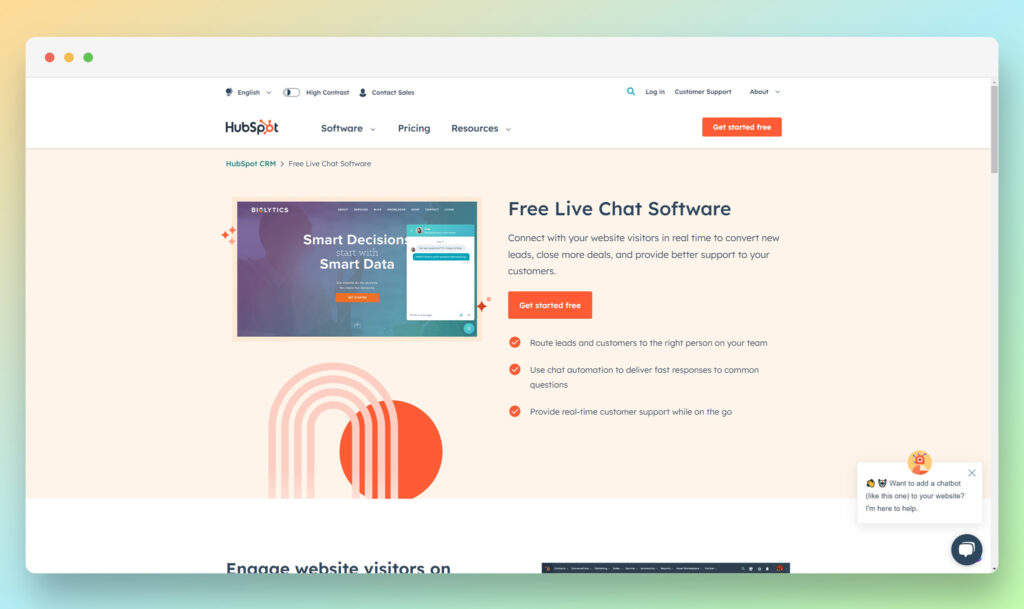
HubSpot is one of the most versatile software companies on the market, offering a range of tools for virtually every kind of business.
The HubSpot portfolio includes a variety of different “hubs”, designed for sales, marketing, and service.
Within the sales landscape, HubSpot offers a free chatbot builder software, which allows companies to qualify leads, book meetings, and provide customer support.
This chatbot builder is one of the easiest options for business leaders, as it requires no coding or programming knowledge.
You can configure your bot to handle all the conversations you like, and even set up triggers to ensure the system directs customers to a human support agent when necessary.
HubSpot’s builder comes with templates designed for specific goals, as well as a visual editor where you can customize conversational flows.
Because the bot is integrated with HubSpot’s free contact database, you can also ensure it’s delivering more personalized experiences.
The free CRM solution available from HubSpot works alongside the chatbot to upgrade support with pipeline management, contact and lead management, insights, forms, and email tracking.
Pricing
You can start using the chatbot builder for free, and access a range of different templates and tools to bring your system to life.
If you decide you want to upgrade your sales strategy, you can also choose from one of HubSpot’s premium packages, which removes HubSpot branding, and come with bonus features like meeting scheduling, live chat, conversation routing and more.
Options include:
- Starter: Starting at $45 per month: US payment management, routing, repeating tasks and queues, multiple currencies, stripe integration, automation, goals, and in-app support.
- Professional: Starting at $450 per month for all the features of Starter, plus sales analytics, automation, CRM configuration, custom reporting, forecasting, sequences, smart sending times, product libraries, phone support, and more.
- Enterprise: Starting at $1,2000 per month: All the features of Professional, plus advanced permissions, sandboxes, hierarchical teams, conversation intelligence, playbooks, predictive lead scoring, and more.
Pros 👍
- Free solution for beginners
- Visual builder with multiple templates
- Seamless CRM integration
- In-depth insights and guidance
- Proactive messaging options
Cons 👎
- Expensive premium plans
- Limited customization on the free plan
2. LiveChat
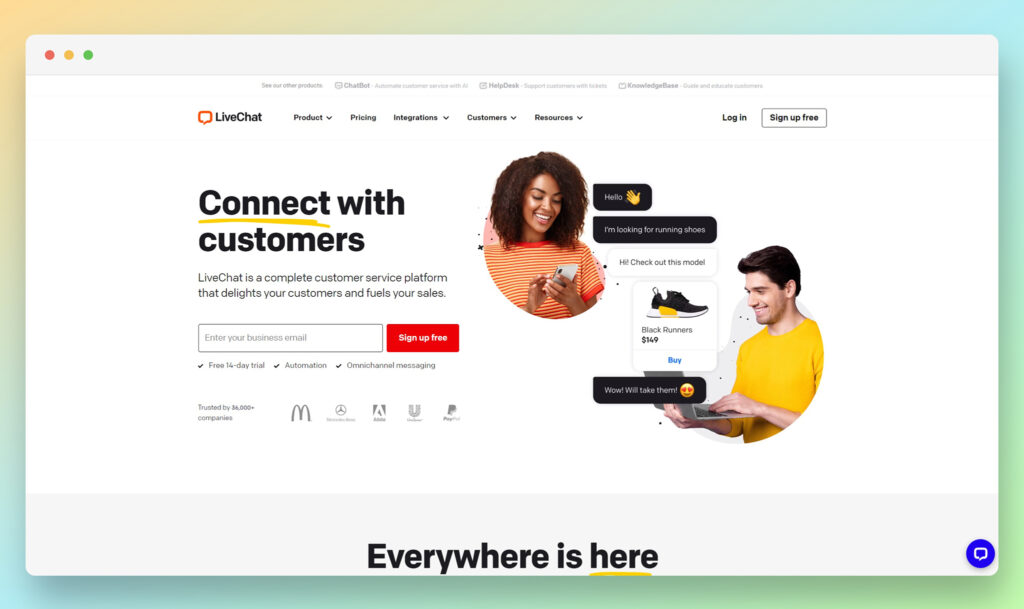
Technically, LiveChat focuses most of its attention on offering customers a comprehensive way for service agents to interact with clients in real-time over the web.
You can connect all of the channels your customers use for messaging in one seamless inbox for your agents.
However, if you want to deliver streamlined and automated service, there’s the option to add a chatbot too.
The LiveChat bot comes with a range of templates to get you started, and there’s no programming or coding required if you don’t have technical knowledge.
You can create welcome bots, afterhours bots, FAQ chatbots and more, to address a range of business goals. The bots can be configured to transfer conversations to human agents whenever you like, and create help tickets for customers.
They can track goals and metrics on the behalf of your company, and automatically send transcripts.
You can even build a chatbot to chat with customers on Facebook messenger, so you can connect with clients where they are.
Plus, there are various carousels, buttons, and quick reply features included, to help you engage and convert your customers.
Pricing
You can try LiveChat for free for 14 days before committing to a specific paid plan. The paid plans start relatively cheap, but you will need to pay for each agent you plan on using with the live chat features. Options include:
- Starter: $20 per month per agent: 60-day chat history, widget customization, ticketing, and data security among other features.
- Team: $41 per month per agent: All the features of Starter, plus an unlimited chat history, full customization, basic reporting, agent groups and multi-branding.
- Business: $59 per agent per month: All the features of Team, plus staffing predictions, work scheduling, more advanced reporting and enhanced service.
- Enterprise: Custom pricing for all the features of Business plus a dedicated account manager, product training, security assistance, single sign-on and HIPAA compliance.
Pros 👍
- Lots of templates based on specific goals
- Integration with messaging tools
- Data security built-in
- Live chat and chatbots in one location
- Reporting and analytics
Cons 👎
- Limited features on some plans
- Relatively basic reporting
3. Tidio
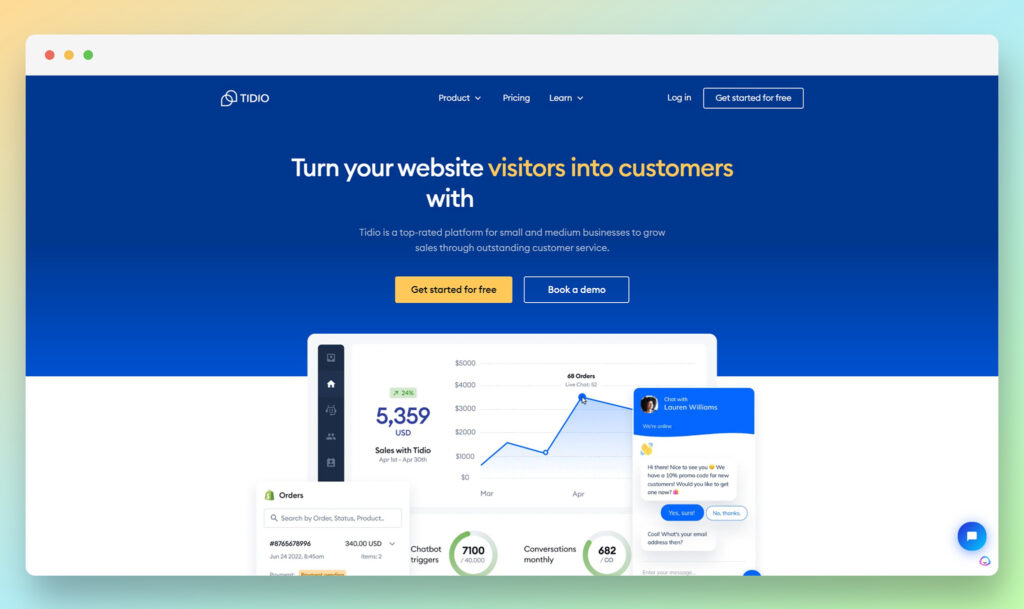
Tidio is a comprehensive customer service platform, offering a range of features to business owners. The chatbot solutions for ecommerce companies can automate customer support, and deliver proactive service, thanks to built-in AI and natural language processing.
There are over 35 templates to choose from when you start building your bot, based on specific goals and requirements.
You can set your bot to offer discounts to recurring customers, recommend products based on browsing history, and reduce cart abandonment. Your customers can even place orders directly within the chatbot widget.
There’s support for automated upselling, lead generation and qualification, and fully automated conversation transfers.
There’s also the option to integrate your bot with various tools you already use, such as your CRM solution, as well as ecommerce platforms like Wix, WooCommerce, and Shopify. Plus, there are built-in mobile and desktop apps, and social media integrations.
Pricing:
There is a free plan available for Tidio which supports access to both Live Chat for up to 50 users, and chatbot conversations with up to 100 users.
This plan also comes with a ticketing system, mobile apps, 3rd party integrations, visitor info, and a JavaScript API. Paid plans include:
- Chatbots: $49 per month per user for conversations with up to 40,000 users, email, 24/5 live chat support, and a range of chatbot templates. You also get a visual chatbot editor and a Zapier integration system for more connections.
- Tidio+: Custom pricing for unlimited live chat and custom chatbot interactions, as well as Tidio AI response bots, multisite support, custom integrations, email marketing, and dedicated customer service.
There’s also a separate plan specifically for those who want live chat functionality.
Pros 👍
- Free plan for beginners
- Exceptional ticketing system
- Integrations with a range of tools, and an API
- Multiple template options with easy triggers
- Lots of customizations
Cons 👎
- Limited paid plan options
- Limited chatbot interactions on all plans
4. Zendesk Chat
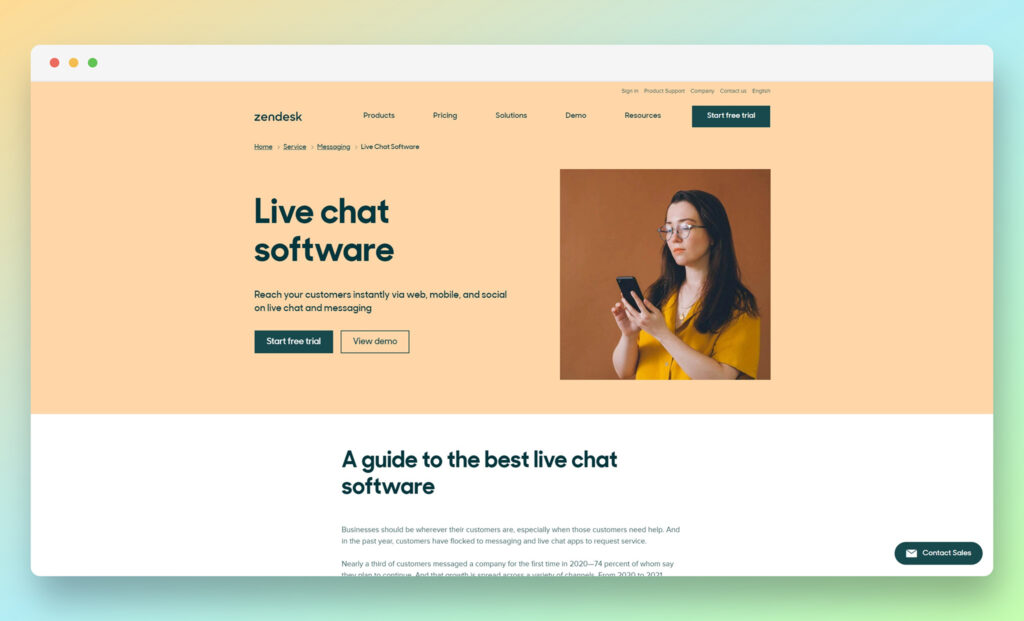
Like many of the other top chatbot solutions for ecommerce, Zendesk is more than just a chatbot builder; it’s also a comprehensive tool for customer service and team alignment.
The AI-powered chatbot solution helps companies to automate simple tasks and deliver better customer experiences, with customizable triggers and workflows.
You can automate responses to frequently asked questions, and send proactive messages to clients to prevent them from leaving your store.
Building a bot is quick and simple, with a convenient set of visual tools. Plus, there are flexible APIs available, so you can easily connect your bot to all of the systems you already use for customer service.
If you don’t want to use APIs, pre-built integrations are also available for a range of popular software solutions.
Zendesk’s comprehensive chatbot solution integrates seamlessly with all of the other tools offered by Zendesk, including a leading ticketing system, messaging options for mobile, web and social, email and voice support, and more.
There’s even the option to build your own intelligent help center, to ensure customers can serve themselves.
Pricing:
To access the Zendesk chatbot, you’ll need either one of the Zendesk service plans. These come in business and enterprise form, depending on the size of your business. There’s also a free trial to get you started. Options include:
- Suite Team: $39 per month per agent for live chat, email, voice, SMS, chatbots, ai-powered automated answers, unified agent workspaces, intelligent routing, reporting and analytics, help center creation, and more.
- Suite Growth: $65 per month for all the features of Suite Team with more automated answers, advanced onboarding and adoption guidance, self-service customer portals, AI-powered knowledge management, service level agreement management and more.
- Suite Professional: $79 per agent per month with up to 500 AI automated answers, custom reporting and analytics, advanced APIs, online support, multilingual support, integrated community forums, and better security
Pros 👍
- Comprehensive support and sales tools
- Customizable API integrations
- Extensive range of triggers and workflows
- Ticketing and knowledge base support
- In-depth reporting and checkout insights
Cons 👎
- Limited chatbot support on cheaper plans
- Some customization limitations
5. Drift

Building a custom chatbot for your ecommerce website couldn’t be easier with Drift. The solution makes it quick and simple to tailor customer conversations, with proactive messaging and customer support options.
You can qualify leads in seconds, send personalized messages based on built-in customer data, and even transfer customers to your service team.
Drift custom chatbots offer deals on your behalf, and create meetings based on calendar integrations with your service and sales teams.
You can also customize conversations by using a visual builder. The powerful technology gives you unlimited ways to connect with your target audience at every stage of the purchasing and research cycle.
There’s also the option to set up comprehensive real-time notifications and conversational landing pages.
Depending on the plan you choose, you’ll be able to implement VIP fast lanes for your most important customers, segment audience groups, and run A/B tests to determine which bots generate the most conversions. There are even advanced routing solutions.
Pricing:
The free plan from Drift comes with everything you need to connect with up to 100 contacts. You can have as many chats as you like, and still access a range of reporting tools and customization options.
However, you’ll need to upgrade to a paid plan for unlimited connections.
Paid plans include:
- Premium: Starting at $2,500 per month with custom chatbots, intelligence, real-time notifications, conversational landing pages, on-demand training and more.
- Advanced: Custom pricing for all the features of Premium, plus Fastlane routing, advanced routing rules, A/B testing and audience segmentation.
- Enterprise: Custom pricing for all the features of Advanced, plus workspaces, AI-powered chatbots, flexible routing, and more customization features
Pros 👍
- Easy chatbot workflow building tools
- Proactive messaging and customer service
- In-depth insights into each customer
- Real-time notifications to boost conversion ate
- A/B testing and analytics
Cons 👎
- Expensive premium plans
- Limited chats on the free plan
6. Meya
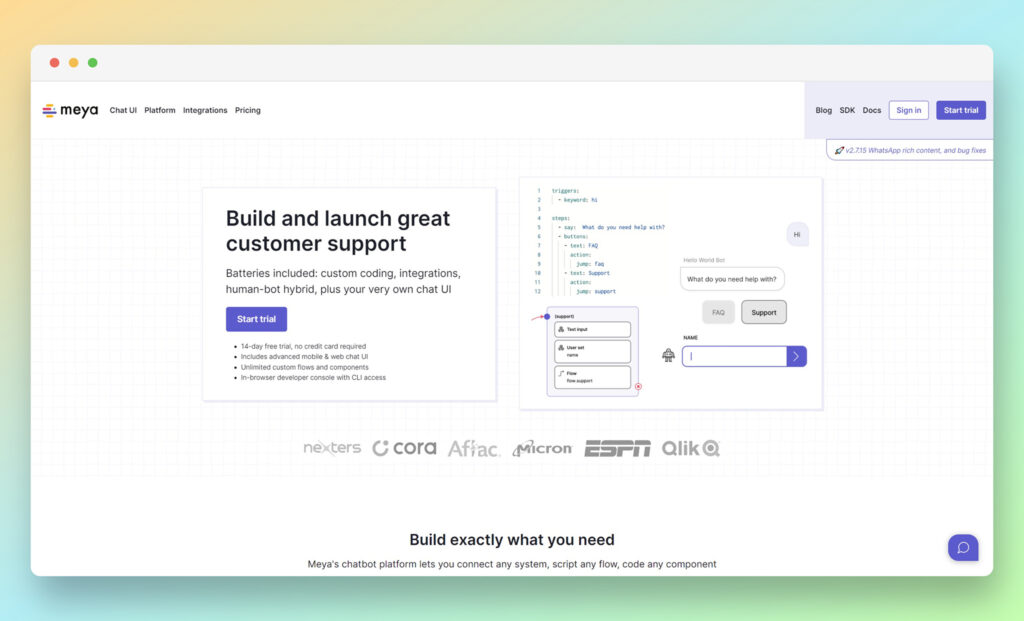
Meya is a fantastic artificial intelligence chatbot platform for companies looking to deliver a highly customized and engaging customer experience.
There’s a little more coding knowledge required with this solution, but you can access a range of flexible routing and trigger options, and even determine exactly when customers are passed to human agents during conversations.
The system can work with a wide range of messaging platforms, including WhatsApp and Facebook Messenger. Plus, you can connect the tools you already use such as Salesforce and analytical systems.
The comprehensive kit comes with support for mobile and web-based apps, for both Android and iOS. With each plan, you also get a range of starter apps to enhance your development process.
The chatbot platform comes with in-depth documentation, a full visual flow editor, BFML and Python code editing, usage analytics and more.
You can also leverage the benefits of natural language understanding to create more human-like bots capable of completing a range of tasks on behalf of your customers and your support team.
Pricing
There’s no free plan for Meya, but you can save some cash by opting for an annual plan instead of monthly payments. The options include:
- Dev: $99 per month for 500 MAU per month and all of the features you need.
- Pro: $999 per month for all the features of Dev, plus 5,00 MAU per month, and volume discounts for your purchases.
- Partner: $3,000 per month for all the features of Pro plus 15,000 MAU per month, and re-seller support.
Pros 👍
- Complete customization
- Endless integrations and add-on options
- Lots of coding options
- Analytics and in-depth insights
- Android and iOS apps
Cons 👎
- Requires some coding knowledge
- Some limitations on customer support
7. ManyChat
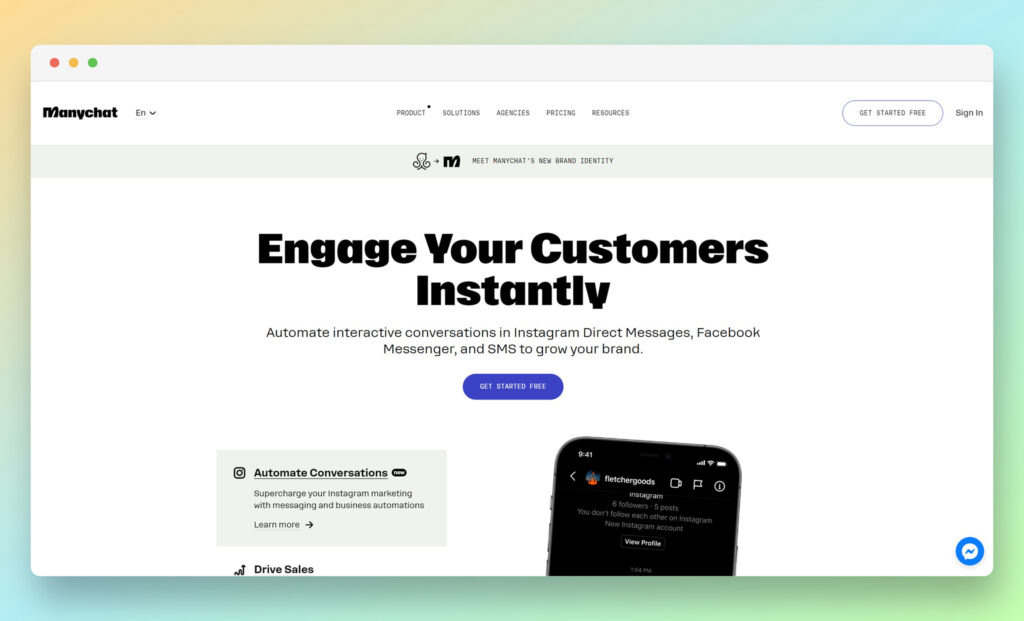
Offering an all-in-one solution for both marketing and customer service, ManyChat is powered by Meta’s messenger app for Facebook, and comes with a range of fantastic features.
There are various tools specifically designed for ecommerce businesses, such as order status checking and abandoned cart support for Shopify. You can also integrate SMS and WhatsApp messaging.
ManyChat bots can be designed to proactively reach out to customers at just the right time to encourage a sale and generate more qualified leads.
You can build automation paths quickly and easily without code, using a visual drag-and-drop interface. Plus, you can connect your system with all of the tools you already use to connect with customers and track analytics.
ManyChat allows you to engage unlimited contacts on the paid plans, and expand your customer reach with growth tools and keyword tracking.
There’s the option to build advanced campaigns with unlimited tags, custom fields and segments. Plus, you get built-in analytics to help you track how your chatbot strategies are driving new sales.
Pricing
The free plan from ManyChat is quite comprehensive, with support for Facebook, Instagram direct messages, and WhatsApp.
You can automate unlimited custom flows for up to 1,000 contacts, access basic growth tools, and segment customers with up to 10 tags. Plus, email support is included.
If you upgrade to the paid plan at $15 per month, you get all the features of the free service, plus support for SMS messaging, and email.
You can also engage unlimited customers, access unlimited growth tools, and build more advanced campaigns. There are enhanced analytics tools included, and you can remove all ManyChat branding.
Pros 👍
- Support for up to 1000 conversations on the free plan
- Tagging and lead segmentation for customer queries
- Integrations with leading chat tools
- Support for email and SMS
- Growth tools to help you expand
Cons 👎
- The visual builder is a little clunky
- Email support is the only option for customer service
8. Intercom
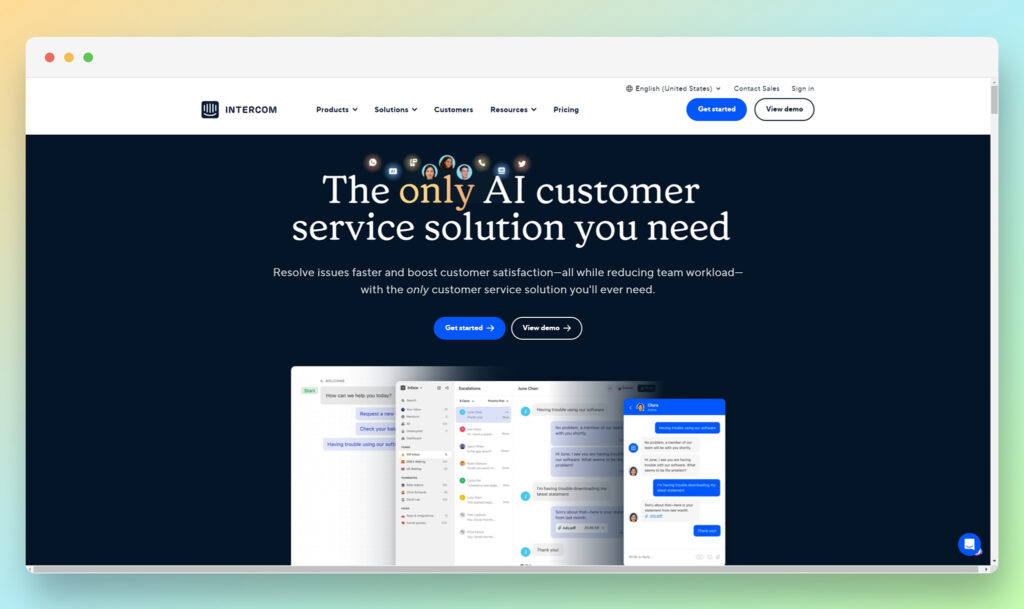
Primarily, Intercom was designed to deliver live customer service, and provide companies with a way to build their own knowledgebase environments.
However, the company has also invested heavily in the creation of AI chatbot tools, which can be designed without any coding. The code-free chatbots can be set up in minutes to scale your team and convert more website visitors.
The visual bot builder included with Intercom makes it quick and simple to get started with your own chat solutions, and you can build as many different bots as you like.
All of the bots are infused with machine learning, so they become more intelligent as they learn about your customers.
Bots can qualify your leads for you and route them to the right team on your behalf.
You can also create different bots for different audiences, setting up solutions for new visitors, customers looking to make a purchase, and more.
Intercom also offers more than 350 integrations with leading email, CRM, ticketing, social channels, reporting tools, and databases. You can send proactive messages across multiple channels, and leverage state-of-the-art security.
Pricing
Unfortunately, Intercom doesn’t offer any transparent pricing packages on its website. You need to request a demo and speak to the sales team to get a clear quote.
However, there are numerous packages to choose from, each with included conversational bots and resolution bots. The price of your package will depend on which features you need
The plans also come with team inboxes, live chat support, role-based permissions, multi-channel campaigns, service level agreement rules, outcome reporting, and smart lead qualification.
Plus, they can all integrate with a range of existing tools.
Pros 👍
- Hundreds of integration options for your online store
- Excellent team management for large companies
- Tons of routing and trigger options
- Machine learning for smarter bots
- In-depth security features
- Integrations with tools like Slack
Cons 👎
- No transparent pricing
- Some limitations on customer support
Further reading 📚
Choosing the Best Ecommerce Chatbots
The number of ecommerce chatbot solutions is growing all the time.
At present, 55% of businesses who use chatbots say they help them to generate more high-quality leads.
What’s more, chatbots can save companies up to 30% on their support costs, as well as saving employees endless time on dealing with repetitive queries.
The challenge for most business owners is simply finding a bot they can rely on to deliver the best results.
Some of the most impressive tools on the market today can help customers with a range of tasks and queries.
Not only do the best ecommerce chatbot examples answer customer questions, but they also engage in conversational commerce interactions that increase sales.
A messenger bot can showcase your personality with Gifs and unique conversational flows, and convince customers to spend more on your Shopify store.
Many of these tools also work across a range of platforms, from Amazon Alexa, to KIK, Facebook Messenger, WhatsApp, and many others.
Some tools can even integrate with social media platforms to help small business owners with retargeting customers that leave their store with personalized offers.
Whether you’re looking for one of the best virtual assistants around to support your service team, or you simply want to increase average order value with a pop up chat widget, there’s something out there to suit every need.
Other options include:
- Telegram
- Live Agent
- Mobilemonkey
- Chatfuel
- Botsify




Comments 0 Responses